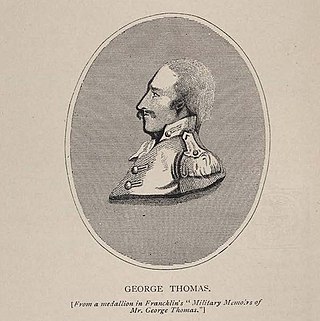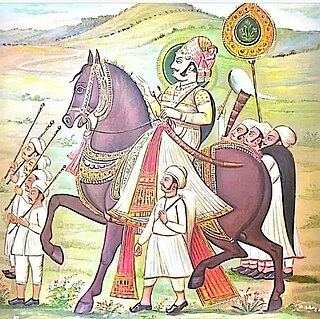
Rajasthan is a state in northwestern India. It covers 342,239 square kilometres (132,139 sq mi) or 10.4 per cent of India's total geographical area. It is the largest Indian state by area and the seventh largest by population. It is on India's northwestern side, where it comprises most of the wide and inhospitable Thar Desert and shares a border with the Pakistani provinces of Punjab to the northwest and Sindh to the west, along the Sutlej-Indus River valley. It is bordered by five other Indian states: Punjab to the north; Haryana and Uttar Pradesh to the northeast; Madhya Pradesh to the southeast; and Gujarat to the southwest. Its geographical location is 23°.3' to 30°.12' North latitude and 69°.30' to 78°.17' East longitude, with the Tropic of Cancer passing through its southernmost tip.

Rao Bika Rathore, was a scion of the Rathore clan of Rajputs and the founder of the city of Bikaner and Bikaner State in present-day state of Rajasthan in India. He was the fifth son of Rao Jodha, founder of the city of Jodhpur. During his reign he controlled an area of 40,000 square miles, which included 3,000 villages.

Fatehabad district is one of the twenty two districts of the state of Haryana, India. Fatehabad was founded by Firuz Shah Tughlaq. Fatehabad district was carved out of Hisar district on 15 July 1997.

Rao Maldeo Rathore was a king of the Rathore dynasty, who ruled the kingdom of Marwar in present day state of Rajasthan. Maldeo ascended the throne in 1531 CE, inheriting a small ancestral principality of Rathore's but after a long period of military actions against his neighbours, Maldeo swept significant territories which included parts of present day Rajasthan, Haryana, Uttar Pradesh, Gujarat and Sindh. He refused to ally with either the Sur Empire or the Mughal Empire.

Rājputana, meaning Land of the Rajputs, was a region in the Indian subcontinent that included mainly the present-day Indian state of Rajasthan, as well as parts of Madhya Pradesh and Gujarat, and some adjoining areas of Sindh in modern-day southern Pakistan.

George Thomas, known in India as Jaharai Jung and Jahazi Sahib, was an Irish mercenary and ultimately a Raja who was active in 18th-century India. From 1798 to 1801, he ruled a small kingdom in India, which he carved out of the Hisar and Rohtak districts of Haryana. He is often known in popular memory as the 'Raja from Tipperary'.

Rajpurohit is a Brahmin sub-caste residing in South Asia natively in western Rajasthan of India. Their ancestors belonged to family line of SaptRishis. They maintain traditions that are similar to both Brahmins and Rajputs. They have been historically engaged in administration, trading, jagirdar, and as royal council members and warriors and are spread across the entire country. They were given villages at boundary of kingdom. According to political analysts, the Rajput, Charan and Rajpurohit communities are considered to be identical in regards to their social customs and political ideologies.
Rania is a town and a municipal committee in Sirsa district located on the upper bank of Ghaggar River in the Indian state of Haryana. Rania Town is a grain market in Sirsa district. Nearby cities to Rania includes Sirsa and Ellenabad. It shares it's RTO office with Ellenabad which is also has its headquarters in Ellenabad. Earlier it was a part of Ellenabad subdivision but later carved out separately as a subdivision in Sirsa district of Haryana. It is at a distance of 22 km each from Sirsa and Ellenabad in opposite direction on Haryana State Highway 32A i.e. Bhambhoor-Jiwan Nagar Road which connects to Haryana State Highway 32 in Jiwan Nagar on one end and Haryana State Highway 23 in Bhambhoor on the other end.

The history of human settlement in the western Indian state of Rajasthan dates back to about 100,000 years ago. Around 5000 to 2000 BCE many regions of Rajasthan belonged as the site of the Indus Valley Civilization. Kalibangan is the main Indus site of Rajasthan, here fire altars have been discovered, similar to those found at Lothal.

Jangladesh, also known as Janglu, was a historical region in north, north-western and north-eastern Rajasthan state in northern India. It included the present-day districts of Bikaner, Churu, Ganganagar, and Hanumangarh. It was bounded on the south by Marwar and Jaisalmer regions, on the east by Ajmer-Merwara region.

Kingdom of Marwar, also known as the Jodhpur State under the British, was a kingdom in the Marwar region from 1243 to 1818 and a princely state under British rule from 1818 to 1947. It was established in Pali by Rao Siha, possibly a migrant Gahadavala noble, in 1243. His successors continued to struggle against regional powers for domination and 9 out of 15 rulers till 1438 died in combat. In 1395, its capital was changed to Mandore by Rao Chunda of Mandore and to Jodhpur in 1459 by Rao Jodha.

Haryana, formed on 1 November 1966, is a state in North India. For the administrative purpose, Haryana is divided into 6 revenue divisions which are further divided into 22 districts. For Law and Order maintenance, it is divided into 5 Police Ranges and 4 Police Commissionerates.
Rajasthani people or Rajasthanis are a group of Indo-Aryan peoples native to Rajasthan, a state in Northern India. Their language, Rajasthani, is a part of the western group of Indo-Aryan languages.
The Sikligar is a community found in the Indian states of Gujarat, Haryana, Rajasthan, and Punjab. By tradition, the Sikligar people specialized in the craft of making and polishing weapons. They are typically Hindu in Gujarat, Telangana, and Andhra Pradesh; Sikh in Punjab; and either Hindu and Sikh in Haryana.
The Mughal–Rajput wars were a series of battles between the Rajput Confederacy and the Mughal Empire. The conflicts originated with the invasion of northwestern India by the Mughal ruler Babur, to which the head of the Rajput confederacy, Rana Sanga, offered staunch resistance.
The Warya is a Rajput clan found predominantly in the Punjab and Sindh provinces of Pakistan and in the state of Gujarat in India.
The Pachhada are a Muslim ethnic group found in the Pakistani Punjab. They are also known as Rath.
Gaur also known as "Gour" is a Hindu Rajput clan of India. They have ancient ancestry and find mention by James Tod as one of 36 royal races in his book Annals and Antiquities of Rajasthan The Gaur Rajputs once held a prominent position in Ajmer till the time of Prithviraj Chauhan. Gorwar region gets its name from this clan. In later years they lost the territories ruled by them. In 15th century, they fought at least 13 battles with Shekhawats were defeated and were reduced to feudetory or jagirdars in Shekhawati region. The Rajgarh territory was one of the last bastion of Gaur Rajputs during the times of Mughal Emperors, Humayun and Akber, which was lost to Kishan Singh in 17th century. Gaur Rajputs remained allies to Mughal till the time of Aurangzeb, whose political decisions, alienated Rathods, Sisodias, Hadas and Gaur Rajput from Mughals.
Bhatti is a Punjabi and a Sindhi caste of Rajputs and Jats. The name Bhatti is a Punjabi form of Bhati, and they along with Bhuttos and Bhatias claim to have originated from the Hindu Bhati Rajputs.










